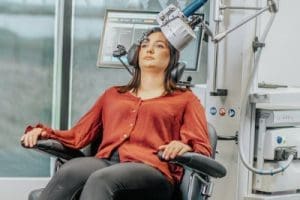After the second antidepressant was declared a failure, your doc said your depression is “treatment-resistant.” You weren’t shocked, but reality and its ramifications hit hard. You’re still shaking your head and saying to yourself, “I don’t want to live like this.”
As a 50 year treatment-resistant anxiety warrior, I’m not naive when it comes to treatment options and efficacy. I get it – I really do.
”Treatment-resistant,” when you’re trying to get a handle on a disabling illness. How wrong is that?
In one way or another, all of the emotional and mental disorders are treatment-resistant. But treatment-resistant depression (TRD) is in a class of its own due to failure of multiple first-line medications, crippling symptoms, and the potential for suicide.
In part one of this two-part series we reviewed managing TRD, factors contributing to resistance. and assessment. Here we’ll handle treatments, emerging treatments, and research.
Intro
Before we get rolling, let’s do some table setting. We’ll start with an astonishing statistic from a 2021 study published in the Journal of Clinical Psychiatry…
The estimated 12-month prevalence of medication-treated major depressive disorder (MDD) in the United States was 8.9 million adults, and 2.8 million (30.9%) had TRD.
Most of what you’re about to read is based upon “Managing Treatment-Resistant Depression: Tips for the Outpatient Psychiatrist,” by Lisa Harding, MD. It was posted last month on Psychiatric Times.
Now, Dr. Harding is addressing psychiatrists. So if you’re grappling with TRD and some of what you’ve read is missing from your treatment experience, enlighten your provider.
Finally, let’s put a definition on the table. According to Dr. Harding, TRD is typically defined as a failure to respond to two or more trials of antidepressant medications (ADs) at an adequate dose and duration.
TRD manifests in various forms, including partial response, nonresponse, or recurrent depression – despite adequate treatment trials.
Onward…
Treatments for treatment-resistant depression
The fact that a depression case is treatment-resistant doesn’t mean it can’t be treated. Dr. Harding offers a comprehensive list of treatments and I’ve put my two-cents in as well.
But a quick word. Please don’t think I believe that listing treatment options means “There you go, you’re all set.”
As a 50 year “treatment-resistant” anxiety warrior, I’m not naive when it comes to treatment options and efficacy. I get it – I really do.
Psychotherapy
Psychotherapy: always an essential piece
Personally, and as a former clinician, I say if an individual is using psychotropic meds to manage their emotional or mental circumstances, psychotherapy should, at the very least, be seriously considered.
Harding submits that therapy should begin when the prospective therapist and treating clinician collectively determine that the patient is at a point where active participation in therapy is feasible and beneficial. Yes, suitability for therapy is a major consideration.
According to Harding, cognitive-behavioral therapy, dialectical behavior therapy, and interpersonal psychotherapy have demonstrated effectiveness in addressing the challenges of TRD.
It’s the experience
She goes on to say that individual therapy plays a crucial role because it can enable patients to learn and nurture essential coping skills, accept lite and attempt to resolve underlying emotional issues, and create achievable goals for their well-being.
I’ll add that working with a good therapist can provide a great deal of comfort. I mean, having someone who accepts you for who you are and has your back when the chips are down is wonderful.
Finally, if you’re working with a quality therapist, it’s crucial to understand that therapy is only as good as you make it. If you don’t accept your illness and you aren’t willing to engage with an open mind, you can forget about relief.
Neuromodulation therapies

Transcranial magnetic stimulation
According to Harding, neuromodulation techniques, such as transcranial magnetic stimulation (TMS) and electroconvulsive therapy (ECT), have, witnessed by recent studies, shown effectiveness in cases of TRD.
Absolutely, neuromodulation remains controversial, especially ECT, but technological and procedural advancements have improved comfort and efficacy.
For instance, thanks to researchers at Stanford University, TMS got a major power and efficacy boost with their Stanford Accelerated Intelligent Neuromodulation Therapy (SAINT), which is now US Food and Drug Administration (FDA) approved for the treatment of major depressive disorder (MDD).
If you’re curious, TMS and ECT are FDA approved for the treatment of MDD. The UKs Royal College of Psychiatrists has approved TMS and established the ECT Accreditation Service.
Dr. Harding didn’t mention deep brain stimulation. I’m thinking because it’s an invasive procedure and still in the investigational stage as a depression treatment. Still, I’d like to give it some attention.
Deep brain stimulation (DBS} is an invasive (no skull opening) procedure involving the implantation of electrodes in target areas deep within the brain. The electrodes produce electrical impulses that regulate abnormalities, including those of impulse, neurons, and brain chemicals.
A pacemaker-like device is implanted under the skin in the upper chest, which governs the level of stimulation.
DBS becomes a treatment option only after the failure of multiple interventions. So this is about TRD. DBS for the treatment of depression is not FDA approved, though procedures are being performed off-label.
Esketamine therapy
Esketamine, an N-methyl-D-aspartate receptor antagonist, has received FDA approval as a rapid-acting antidepressant. It’s also been approved for the treatment of MDD with acute suicidal ideation.
Esketamine is administered intranasally under medical supervision.
Ketamine infusion therapy
Intravenous ketamine is being used off-label for the treatment of TRD with reported benefits. I know two people who use it. Treatment clinics are fairly easy to find online. Just pay attention when they talk about price.
Lifestyle modification.
This is one of those things I probably don’t have to tell you, but will anyway. Poor sleep, lousy diet, and lack of physical activity can make the TRD experience so much worse. All of them deserve priority focus.
And let’s go ahead and mention environmental factors. Lack of social support, family and work stressors, and poor access to healthcare are sure to exacerbate symptoms. Again, goes without saying?
Stress managing activities
Name them: meditation and mindfulness, yoga breathing exercises, guided imagery, progressive muscle relaxation, and more – with regular practice, all of them can reduce the emotional and mental impact of TRD.
Supportive care, monitoring, and follow up
A strong support system is vital for anyone enduring TRD. It can include a spouse or partner, family member, friends, clergy person, and support groups. Harding emphasizes the avoidance of the dangers of social isolation.
And it’s important to have an open line of communication with your providers. They need to be kept abreast on your progress. Monitoring and communication can help identify emerging issues and facilitate timely interventions.
So you know, Harding states that patients with TRD need to be monitored as they start new therapies. If new medications are started, four to six weeks is a general guideline to monitor for adverse effects and for response.
She adds that when a patient is receiving an intervention, such as TMS, ECT, or esketamine, monitoring by clinical staff during and in follow up to the procedure is crucial.
The invisible
All of the interventions we’ve reviewed can be seen or touched. But I believe there are interventions that can’t experienced with the eyes or fingers – the invisible, if you will.
How ‘bout an example. I was having a particularly challenging go with anxiety yesterday afternoon. You know how it goes.
I have a Bible app on my phone and suddenly a message popped up, which rarely happens. In so many words it said God has my back regarding my anxiety – and not to worry. Now, I’m not the most trusting soul in the world, but I believed the message and was comforted by it.
What about you? Are there spiritual – invisible – sources of power you can turn to for help and hope? Could be a traditional God, could be that tree you’ve always loved. But I don’t know why someone who’s suffering wouldn’t want to believe there’s a force beyond comprehension that has their best interests at heart..
Emerging treatments and research

Research and development: it goes on
If you’re struggling with TRD, can you imagine how you’d feel if nothing was going on in the emerging treatments and research neck of the woods? Right?
Be it meds, neuromodulation devices and techniques, therapy, genetics, and more – the work goes on. In this piece we’re emphasizing meds; however, if you’d like to look into other treatments in development anywhere in the world, head over to clinicaltrials.gov.
The meds pipeline
We’ve always followed the meds pipeline here on Chipur. Yes, meds aren’t the only treatment act in town; however, knowing there may be something really good in the pipeline fosters hope.
Two months ago I posted the two-part series, The psychiatric medication pipeline: What’s the latest? We took a look at drugs in development for generalized anxiety disorder, MDD, PTSD, ADHD, and schizophrenia.
Let’s see what’s cooking in the MDD kitchen…
Esmethadone
Esmethadone is a NMDA receptor antagonist that’s believed to modulate the glutamate (neurotransmitter) system, generating antidepressive effects. It also increases levels of critically important BDNF.
FDA phase 3 (out of 3) studies are underway.
Navacaprant
Navacaprant targets κ-opioid receptors. It’s particularly effective in addressing anhedonia (inability to feel pleasure) in patients with moderate to severe MDD.
Phase 3 studies have begun.
Psilocybin
And now for the star of the show, psilocybin. I know several people using it to treat their depression, but although it’s registered with the FDA, and under aggressive study, it’s still an investigational chemical.
As you likely know, psilocybin, a Schedule 1 hallucinogen, is a naturally occurring molecule that exists in more than 200 species of Basidiomycota mushrooms. Its primary mechanism of action appears to be agonism at the serotonin 5-HT2A receptor, which is a common target for the treatment of depression.
Phase 3 studies are underway. It seems as though there’s a lot of momentum behind the eventual FDA approval of psilocybin for the treatment of depression and TRD – along with other clinical applications under investigation.
Keep at it, be hopeful, and never give up
Yet another article I worked up a sweat writing. But I hope you agree it was worth it – as was the series.
If you’re struggling with treatment-resistant depression, info and resources are valuable. Providing both is the intent here.
Please be good to yourself. Keep at it, be hopeful, and never give up. Who knows, your suffering may be for reasons beyond your comprehension.
If you or someone you care about are in immediate danger of any form of self-harm call 988 in the U.S. And here’s a list of international suicide hotlines.
If you’d like to read Dr. Harding’s piece, here you go: “Managing Treatment-Resistant Depression: Tips for the Outpatient Psychiatrist.”
And here’s the study with the statistic I mentioned: “The Prevalence and National Burden of Treatment-Resistant Depression and Major Depressive Disorder in the United States”
If you’d like to read more Chipur info and inspiration articles, review the titles.
TMS content image: Magstim

After a decades-long battle with panic, generalized anxiety, fluctuating moods, and alcohol dependence; Bill finally found his life’s passion and work – lending a hand to those in the same boat. At age 49 he hit grad school and earned his counseling credentials. And he continues his service through Chipur and other projects.











